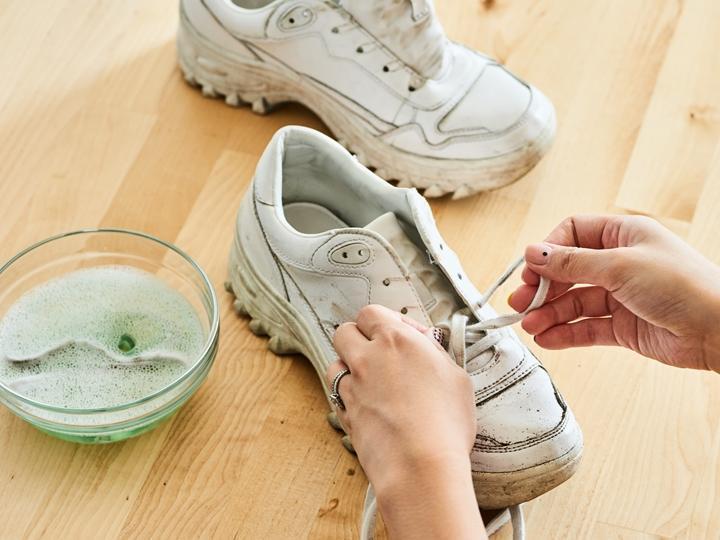Insoles are often the filthiest part of your shoes as it’s the first place where dirt and sweat end up. Thankfully they are quite easy to clean and here we take a look as to how to give your shoes the refresh they need.
How To Clean Shoe Insoles
The best way to clean insoles is simply by brushing them in a soap and water solution. You can also sanitize them with a disinfecting spray and remove bad smells with baking soda.
Soap and water
You can’t go wrong with some soap and water when it comes to cleaning your insoles. It’ll make your life a lot easier if you can remove them. Some are easily removable and others can be removed by softening the glue inside.
If you didn’t want to remove them then you can get inside the shoes with a small brush, such as a toothbrush.
Submerging your insoles is generally not a great idea as this can damage them. Instead, it’s best to make up a solution of warm water and soap in a separate bowl.
The best tool for the job is then a stiff brush which you can then dip into this solution. If you haven’t got a stiff brush then you can use plenty of other things as a replacement such as a dish sponge or washcloth.
You only want to use a small amount of water and brush your insoles in a circular motion. It’s best to do this pressed against a hard surface as otherwise, you won’t get the desired pressure level. It’s best to do both sides as bacteria will be all around the insole.
Once you have cleaned them then wipe down any leftover soap with a clean cloth. The next step is to air dry them and you can do so in direct sunlight.
Bacteria thrive in warm and moist environments so you want them to be completely dry before reinserting them.
Disinfecting them
If you aren’t too bothered about the look of your insoles and just want to disinfect them then there is plenty you can do. You have household disinfectants to hand such as rubbing alcohol, white wine vinegar or hydrogen peroxide can be used.
If you don’t have any of those then you can just use store-bought disinfectant.
Completely remove the insoles from the shoe as you’ll get much better results. Use a spray bottle as this will give the insoles a good covering of solution but without using up too much. As mentioned, you want to avoid getting insoles too wet.
You can then hang your insoles to dry and the solution would have killed the bacteria on them and therefore the smell too. It’s good to give your shoes a little spray of the disinfectant solution too and then let them dry naturally.
Removing odors
One of the worst things about old shoes is the odor. Bacteria will thrive in them over time and this is where the smell comes from. One legendary way of removing bad smells is with baking soda and you can use this on your insoles too.
The way to do this is to trap your insoles in with some baking powder. This can be done in any container you can shut or something else like a Ziploc bag. You simply need to make sure that no air or moisture can get it.
You want to put enough baking powder into the container that the as much of the surface of the insoles are in constant contact with it. You can then leave the baking powder to work for around 8 hours so leaving them overnight will be more than enough.
The next day you’ll find that your insoles have no smell and you won’t have to worry about drying them. Simply brush off any excess baking powder and put them back into your shoes.
Frequently Asked Questions
Can you wash the insoles of your shoes?
You can wash the insoles of any shoe but some are harder than others. The methods that we’ve looked at here are perfect for removable insoles. If your insoles are glued in then you can adapt them to your needs.
How do you clean nonremovable insoles?
A spray solution is a great way to disinfect non removable insoles as they will cover them without getting them too wet. For deeper cleaning, a longer brush such as a toothbrush can be used, and then any excess moisture soaked up with tissue before you air-dry the shoe.
How do you remove shoe insoles?
If an insole doesn’t come straight out then it may be tacked or sewn in. This is rare and it’s much more likely that it has been glued, if so, heat will usually soften the glue to a point where you can peel it out. This makes it much easier to clean and also replace them with orthopedic insoles.
If they are tacked or sewn in then they are much harder to remove as they’ll either need to be pried out or cut out. In either situation, it’s probably easier to leave the insole inside and clean it the best you can.
How do you kill bacteria in shoes?
There are countless products on the market that will do a good job of killing bacteria in your shoes. This includes sprays, pods and inserts that can be quite expensive. We’d recommend a simple household disinfectant spray and you don’t need to get one especially for shoes.
As we mentioned above, there is are plenty of household disinfectants you can use instead which may save you a trip to the shops. These include baking powder, vinegar and rubbing alcohol.
Does freezing your shoes kill fungus?
This is often seen as a life hack but it’s often not quite as effective as other methods as the smell can come back after the shoes have thawed. You also risk getting bacteria on your food so your shoes need to be sealed.
If you do want to dry it then make sure your shoes are completely dry but it may be better using other methods.

